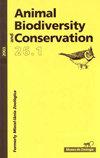人类主导的农业生态系统中潘帕斯鹿的栖息地
IF 1
4区 环境科学与生态学
Q3 BIODIVERSITY CONSERVATION
引用次数: 0
摘要
潘帕斯鹿Ozotocerus bezoraticus uruguayensis亚种是乌拉圭东南部的一种特有的濒危鹿。然而,关于其在农业生态系统中的家园范围要求的知识很少。我们的目的是在两年内调查十只戴无线电项圈的潘帕斯鹿,以监测它们的活动。平均家庭范围为5.54±3.18平方公里。监测的所有个体的核心面积为0.87平方公里,与肉牛的放牧作物一致。该群体表现出亲语文行为,在性别和季节方面,在总职业面积上没有发现显著差异。本文章由计算机程序翻译,如有差异,请以英文原文为准。
Home range of pampas deer in a human–dominated agro–ecosystem
The subspecies of pampas deer Ozotocerus bezoarticus uruguayensis is an endemic and endangered cervid from southeast Uruguay. However, knowledge regarding its home range requirements in agroecosystems is scarce. Our aim was to survey ten radio–collared pampas deer for two years to monitor their movements. The mean home–range size was 5.54 ± 3.18 km2. The core area size for all individuals monitored was 0.87 km2, which concurs with grazing crops for beef cattle. The population showed philopatric behavior and no significant differences were detected in the total area of occupation in respect to sex and season.
求助全文
通过发布文献求助,成功后即可免费获取论文全文。
去求助
来源期刊

Animal Biodiversity and Conservation
农林科学-动物学
CiteScore
2.00
自引率
0.00%
发文量
21
审稿时长
>12 weeks
期刊介绍:
Animal Biodiversity and Conservation (antes Miscel·lània Zoològica) es una revista interdisciplinar, publicada desde 1958 por el Museu de Ciències Naturals de Barcelona. Incluye artículos de investigación empírica y teórica en todas las áreas de la zoología (sistemática, taxonomía, morfología, biogeografía, ecología, etología, fisiología y genética) procedentes de todas las regiones del mundo. La revista presta especial interés a los estudios que planteen un problema nuevo o introduzcan un tema nuevo, con hipòtesis y prediccions claras, y a los trabajos que de una manera u otra tengan relevancia en la biología de la conservación. No se publicaran artículos puramente descriptivos, o artículos faunísticos o corológicos en los que se describa la distribución en el espacio o en el tiempo de los organismes zoológicos.
 求助内容:
求助内容: 应助结果提醒方式:
应助结果提醒方式:


